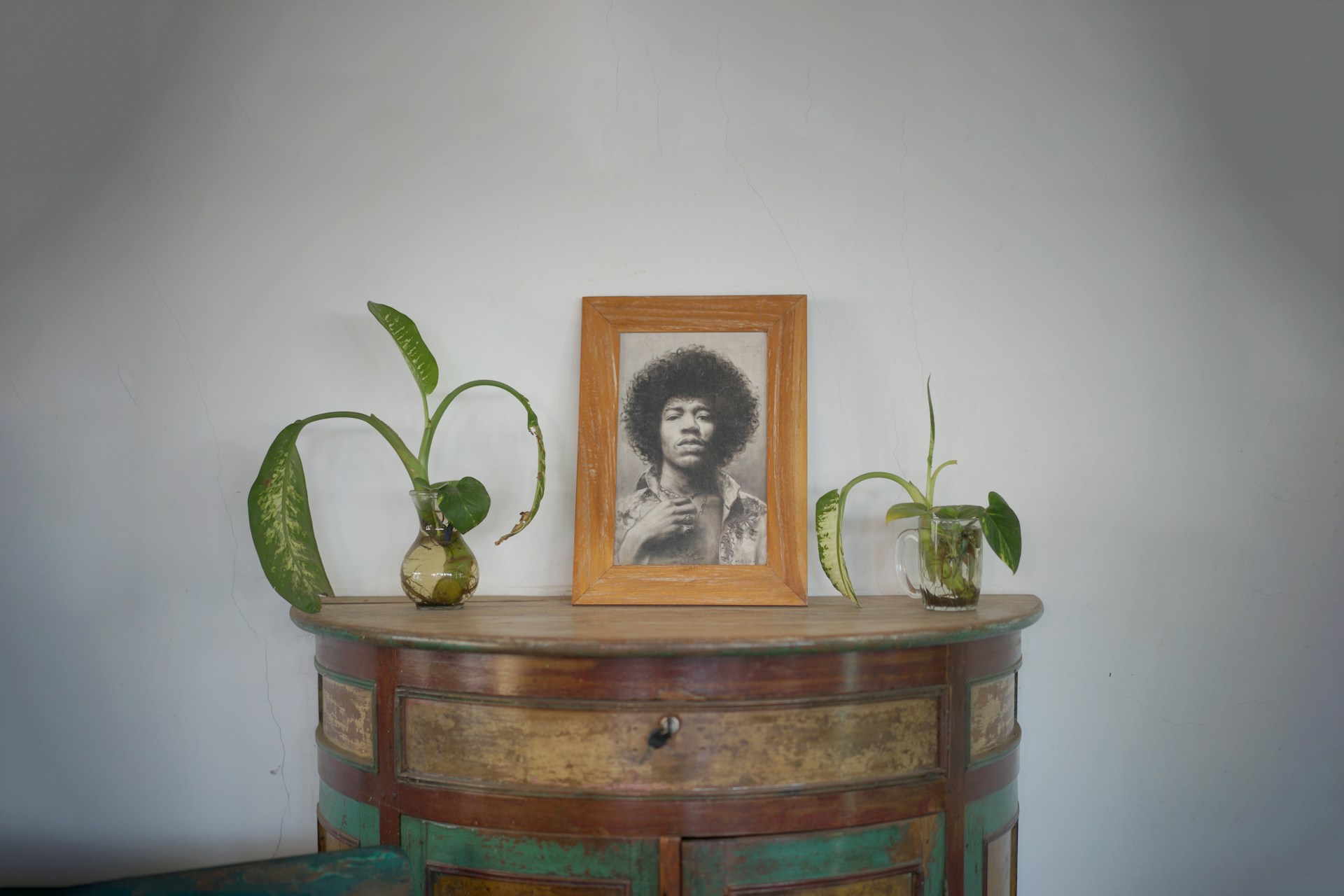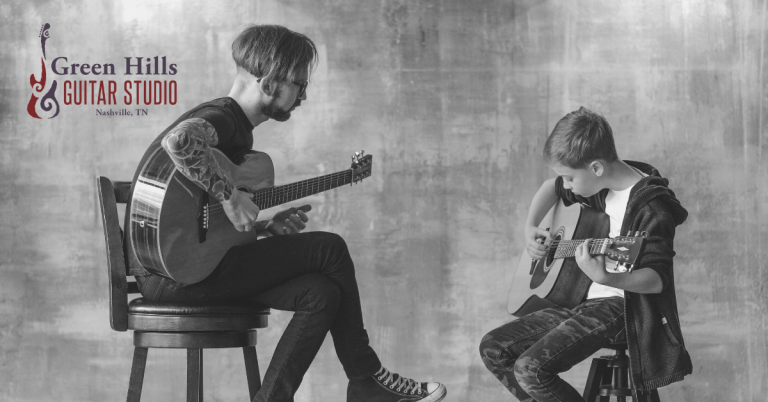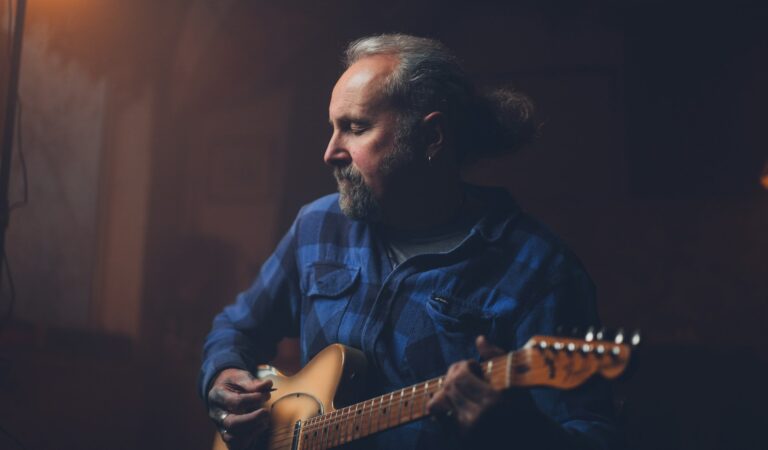The Lasting Power of the Jimi Hendrix Guitar Style
Few guitarists have cast as long and luminous a shadow over modern music as Jimi Hendrix. More than a virtuoso, he was a sonic architect who transformed the electric guitar into an instrument of deep emotional storytelling. The Hendrix guitar style—marked by expressive phrasing, dynamic tone, and fearless improvisation—set a new standard for what the instrument could communicate.
Hendrix broke the rules with purpose. He redefined tone, rhythm, and the intimate relationship between the player and the instrument. His influence still echoes through the hands of guitarists across genres and generations.
Today, you can hear his DNA in the expressive styles of John Mayer, John Frusciante, David Gilmour, Stevie Ray Vaughan, Kenny Wayne Shepherd, Marc Ford, Neil Young, and Doyle Bramhall II.
In this post, we explore Hendrix’s timeless techniques, innovations in tone, and how you can learn his vocabulary through the “Hey Joe” course at Green Hills Guitar Studio.
Hendrix’s Signature Style: More Than Just Notes
At the heart of Hendrix’s genius was his ability to make the guitar breathe, speak, and feel. He wasn’t interested in speed or showmanship—his playing was about conversation, color, and emotional weight.
He didn’t just play over chords—he played inside them.
- Thumb-over grips allowed him to voice complex chords while freeing his fingers for melodic flourishes.
- Chordal fills and rhythmic double-stops blurred the line between rhythm and lead, weaving harmonic movement into groove.
- He integrated major and minor pentatonic scale shapes directly into chord positions, creating fluid transitions and internal motion.
- Perhaps most remarkably, his sense of space gave equal power to silence—phrases breathed, paused, and landed with emotional gravity.
You hear this expressive language in tracks like Little Wing, The Wind Cries Mary, and Castles Made of Sand—songs in which the guitar doesn’t just accompany the voice; it becomes it.
Guitar Tone and Effects: His Palette of Expression
Hendrix didn’t just play differently—he sounded like no one else. His tone was a carefully sculpted blend of guitar, amp, pedals, and instinct. Every tool on his board wasn’t just functional—it was emotional.
Guitars & Amps:
- Fender Stratocasters, flipped for left-handed use, gave him access to brighter single-coil clarity and more expressive whammy bar play.
- Marshall Super Lead stacks provided the bold, blooming overdrive that defined his signature roar.
Pedals:
- Fuzz Face (germanium and silicon): Delivered the wooly warmth of Fire; snarling bite on Voodoo Child
- Vox Wah: Added expressive vocal sweeps and funky, percussive texture.
- Uni-Vibe: Created the watery swirl of Machine Gun, mimicking rotary speaker depth.
- Octavia: Stacked an octave above the note, adding psychedelic sharpness to Purple Haze.
- Echoplex Delay: Gave space and subtle repeats, as heard on the dreamy Third Stone from the Sun.
Hendrix constantly reconfigured his guitar effects chain—sometimes placing fuzz before modulation for aggressive saturation and tweaking amp volume for natural breakup. Delay and wah weren’t static textures; they were living, reactive parts of his phrasing. His tone wasn’t preset—it was played.
The Studio as Instrument: Hendrix’s Sonic Canvas
For Hendrix, the studio wasn’t a place to capture sound—it was a place to reshape it. Working closely with engineer Eddie Kramer, he used the mixing board like a painter’s palette, layering textures, bending time, and widening space.
On Electric Ladyland, the guitar doesn’t just play—it floats, melts, and explodes. You’ll hear guitar lines swirling across the stereo field, tape run in reverse to create ghostly echoes, and flanging that bends reality around each phrase. Tracks are multi-layered, with each guitar tone occupying its color spectrum. Reverb and delay are not just effects—they’re moods.
Want a masterclass? Listen to 1983… (A Merman I Should Turn to Be)—it’s a sonic hallucination built from tape, time, and fearless creativity.
The Hendrix Legacy: Modern Guitarists Who Carry the Flame
Hendrix didn’t just leave behind imitators—he left behind interpreters. His vocabulary of emotive bends, rhythmic fills, fuzz textures, and hybrid rhythm-lead phrasing lives on in modern players who continue to evolve his sound.
John Mayer fuses pop melody with blues phrasing, often using Hendrix-style thumb-over grips, double-stops, and fuzz-drenched solos. Tracks like Gravity and Bold As Love are steeped in his dynamic touch and expressive bends.
John Frusciante channels Hendrix’s sense of movement in rhythm parts, especially through Stratocaster tones, clean arpeggios, and pentatonic fills. In Under the Bridge and Dani California, you can hear the same conversational interplay between chord and lead.
David Gilmour carries Hendrix’s melodic torch into atmospheric territory. His solos in Comfortably Numb and Shine On You Crazy Diamond are built on vocal bends, minor pentatonic phrasing, and delay-soaked sustain—less flash, more soul.
Stevie Ray Vaughan didn’t just cover Hendrix—he expanded him. From the explosive pyrotechnics of Voodoo Child to the lyrical phrasing in Little Wing, SRV added Texas heat while preserving Hendrix’s emotional fire.
Kenny Wayne Shepherd, Marc Ford, Neil Young, and Doyle Bramhall II each trace Hendrix’s DNA in their tone, phrasing, and harmonic storytelling—whether it’s Ford’s bluesy slides, Young’s raw feedback, or Bramhall’s wah-soaked, thumbed-chord soul.
The Power of Rhythm: Hendrix as a Groove Architect
Hendrix didn’t draw a line between rhythm and lead guitar playing—he blurred them into one expressive voice. His grooves breathed. They moved, morphed, and shimmered with melodic detail. He played rhythm guitar not as an accompaniment but as an extension of his phrasing.
He reimagined chord inversions to shift voicings and expand harmonic color. He laced major and minor pentatonic fills between phrases, letting melodic fragments bloom inside progressions. His use of double-stops and hammer-on embellishments inside chord shapes gave each phrase its pulse. And his sliding voicings added fluid, almost vocal movement through chord changes.
This rhythmic integration wasn’t just a style—it became a language. It turned the guitar into a storytelling tool, setting the foundation for generations of players to fuse groove and melody as one.
Hey Joe and the Architecture of Hendrix’s Style
Though Hey Joe was originally penned by Billy Roberts and recorded by several artists in the early ’60s, it was Hendrix’s version that transformed the tune into something timeless. In his hands, what had been a brisk folk-rock track became a brooding, spacious ballad—a showcase for tone, phrasing, and emotional narrative.
Descending chord progression: C – G – D – A – E
A movement through the circle of fifths that mirrors the lyrical descent of a man on the run. But Hendrix didn’t just play this sequence—he recomposed it in motion.
He voiced chords across the neck using inversions and partial shapes, creating variety and flow. He threaded in major pentatonic fills, descending bass runs, and melodic fragments that blurred the line between rhythm and lead. Each chord became a canvas for nuance—slides, double stops, and volume swells added breath and dynamics.
The solo doesn’t aim for speed—it aims for feeling. Built from the E minor pentatonic and blues scale, it leans on vocal-like bends, vibrato, and strategic silence. Hendrix lets the phrases unfold naturally, with tension and release shaped more by touch than technique.
The result is a masterclass in restraint, melodic architecture, and expressive control—a complete embodiment of what the Hendrix guitar style makes possible.
Why the Hendrix Guitar Style Still Matters to Modern Players
Hendrix didn’t just play notes—he painted moods. He turned scales into poetry, chords into conversation, and silence into meaning. In a world of presets and perfection, his music reminds us what it means to play with soul, not just precision.
To learn the Hendrix guitar style isn’t to imitate—it’s to awaken your own voice through tone, phrasing, and fearless expression.
Learn How to Play Hey Joe the Hendrix the Right Way with Green Hills Guitar Studio
- Move chord shapes and inversions fluidly up the neck
- Add major pentatonic fills that weave through progressions
- Blend rhythm and lead with double-stops, slides, and voicings
- Shape tone and phrasing with Hendrix’s dynamic control
- Rebuild Hey Joe from the ground up—solo, fills, chords, and nuance
This isn’t just a song tutorial—it’s a structured breakdown of Hendrix’s vocabulary in action.
Ready to level up? The Hey Joe course is included in our All Access Pass, giving you complete entry to all Green Hills Guitar Studio courses—online and in-person. Whether in Nashville or learning from home, you’ll get expert guitar instruction rooted in real musical language.






